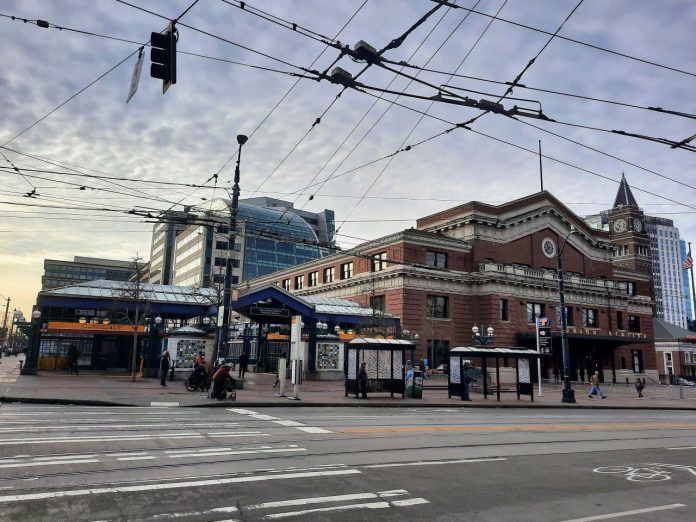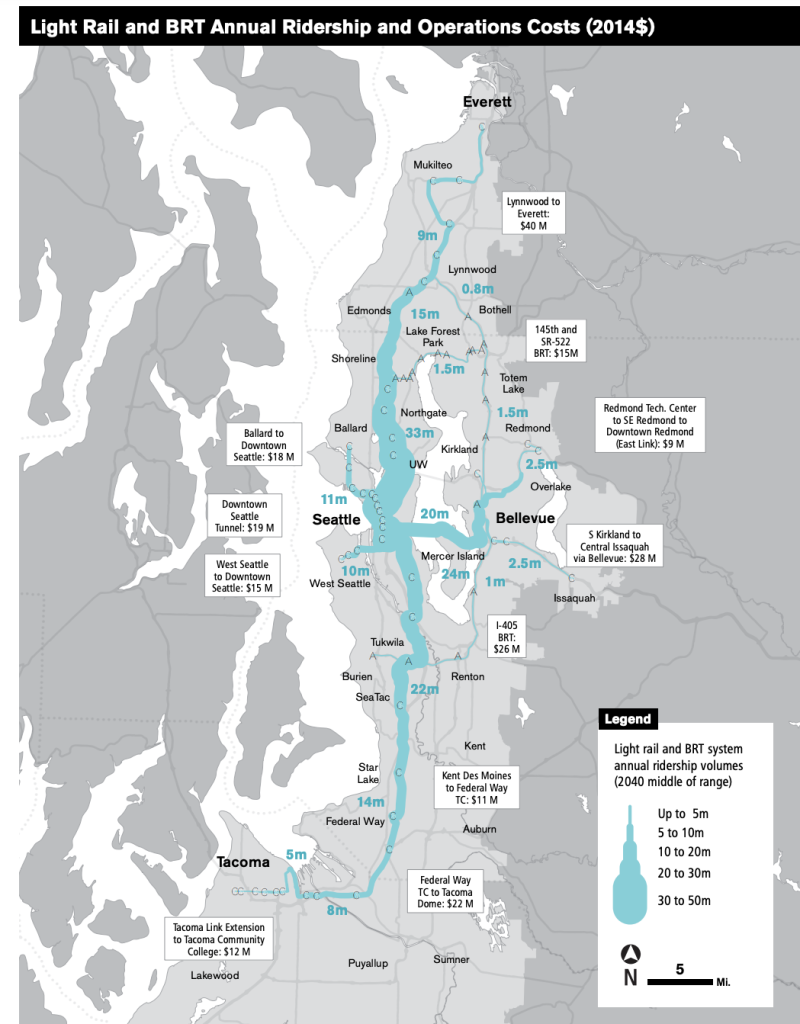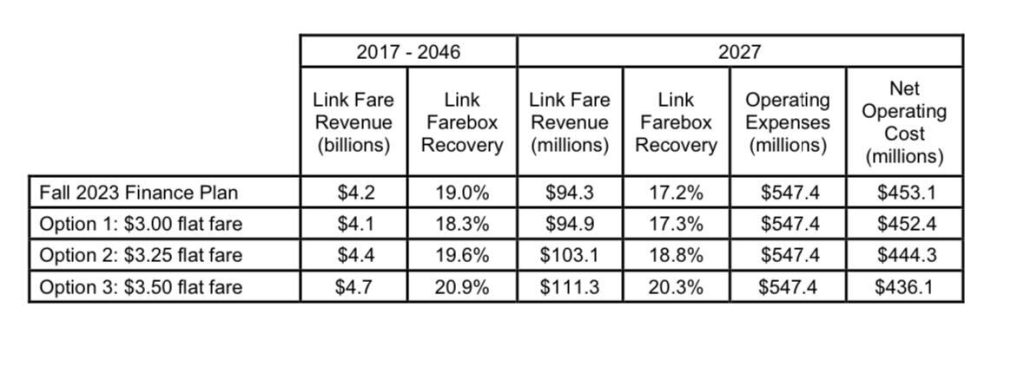
The change hiking fares on short-distance riders and lowering them for long-distance trips will go into effect when Lynnwood Link opens in the fall.
Three-dollar light rail fares will be the rule of the land after the Sound Transit Board of Directors approved the change in an unanimous vote on Friday. For short trips, riders will experience the move as a 33% fare hike over the existing $2.25 base fare. However, riders going long distances on Link will actually experience the fare change as a savings since the existing distance-based system currently tops out at $3.50 for the longest trips.
The highest fare had been set to go to $4.25 with the Lynnwood Link Extension. Instead that extension (set to open fall 2024) will trigger the shift to a flat fare system.
That said, the bulk of Link ridership is shorter trips in the lower fare tiers, and the highest fares are relatively uncommon trips. Today, two-thirds of riders who tap on and off with their ORCA transit card spend $2.50 or less. Even if Sound Transit had kept the distance-based fare system, staff had planned to hike the base fare by $0.25 or more in order to get closer to the agency farebox recovery target ratio and improve its debt coverage ratio.

The new fare structure will not affect low-income adult or senior/disabled fares, which will remain $1 with an ORCA Lift or regional reduced fare card. Youth 18 and under will also continued to enjoy zero-fare transit.
With pressure from transit advocates and some boardmembers, staff pledged work to promote the ORCA Lift program so more eligible riders apply. The program’s eligibility threshold is set at 200% of the federal poverty line. As it stands, local transit agencies are only about halfway to their goal of 80,000 active Lift passes distributed.
Sound Transit said 46% of Link passengers pay the adult fare with the remainder using employer-funded passes or reduced fare products based on the most recent fare data.
The need to tap off the system in order to avoid paying the highest fare is a drawback of distance-based fares that agency staff and boardmembers brought up. King County Councilmember Claudia Balducci, in particular, stressed this point, saying flat fares would reduce stress and confusion for new riders by avoiding the tap-off step. The simplicity of flat fares was a major selling point for the board.
“With easy-to-understand pricing, and ORCA programs to match every income, there’s never been a better time to get on board Link,” said King County Executive and Sound Transit Board Chair Dow Constantine in a prepared statement. “Link is expanding to serve more and more communities over the next few years, and this simple pricing will make getting where you need to go even easier.”
Constantine also pointed to regional integration of fares, noting that King County Metro is planning to increase its $2.75 flat fare to $3 in the near future. No local transit agencies have a $3 fare currently.
Board and staff also painted flat fares as more compatible with fare capping, a policy that helps control costs for riders by limiting the maximum charge they can incur in one day, week, or month. However, fare capping would be technically feasible under any fare system and even under flat fares the prospect remains theoretical at this point, with staff pledging to work on the idea. The agency made no promises on a fare capping implementation date yet.
Sound Transit acknowledged that the public had not yet been convinced that flat fares would be an improvement: “Extensive community engagement found the public almost evenly split on whether to continue with distance-based fares or move to flat fares,” the agency said in a prepared statement. “In making the change, board members emphasized increased simplicity and the potential for fare capping in the future, as well as equity concerns.”
Sound Transit's financial plan assumes raising fares by $0.25 every four years. That means in ~16 years when Ballard Link opens, we'd be looking at a $4 flat fare. https://t.co/b5dBBpH15L
— The Urbanist (@UrbanistOrg) December 15, 2023
In fact, the agency’s survey found 52% of full-fare Link riders opposed the switch to flat fares, although the move was a bit more popular among future Link riders who said they’d ride once system extensions reach them.
Despite encouragement from The Urbanist and other transit advocates, Sound Transit did not study zone-based fares, which could have offered an alternative that simplifies fares instead of going to a fully flat system that loses the incentive to take shorter light rail trips. While the agency has refused to study the idea, future system extensions could provide a catalyst to do so.
Seattle Mayor Bruce Harrell did acknowledge the pushback he heard from Seattle residents, and shared a desire to monitor the new fare system for flaws and reassess if ridership took a hit.
“I am concerned about the results, one year, two year, three year from the shorter distance rides when we look at ridership,” Harrell said. “We have to be, to some extent, pliable, because if we see a significant decrease in ridership, which, of course, is contrary to everything we’re trying to do, we always reexamine some of our assumptions. Again, I wanted to recognize people in Seattle, some of whom were against a flat-based fee just because of the impact on ridership — people who rely on this transit for their day-to-day jobs, many of whom are on lower or fixed income.”
Some boardmembers — including Pierce County Executive Bruce Dammeier, Snohomish County Executive Dave Somers, and Lynnwood Mayor Christine Frizzell — expressed concerns that the $3 flat fare might hurt the agency’s finances and shared a preference for a $3.25 fare. The agency projected a $3.25 flat fare would improve its debt capacity and coverage ratio, but the lower $3 fare would worsen it slightly.

Somers also alluded to stricter fare enforcement measures, potentially including installing fare gates — a proposal that Sound Transit has studied but kept under wraps until The Urbanist broke the story last month.
It seems likely councilmembers seeking higher fares will get their way eventually, barring an overhaul of the agency’s financial plan, which assumes a $0.25 fare hike every four years. That hasn’t happened in practice, with the agency’s last Link fare hike in 2015. However, the financial pressures are only growing as Sound Transit ramps up expansion projects toward its vision of a 116-mile light rail system complimented by its 50-mile-plus Stride bus rapid transit system. Operating costs will only climb.
Ultimately, arguments that a gentler fare hike would be more palatable and less of a ridership hit won the day. Thus it will cost the same to ride Link nearly 30 miles from Lynnwood to SeaTac as it will be ride it three miles from U District to Capitol Hill. And barring the agency adopting a new policy, flat fares will remain even as the system grows from Tacoma to Everett and reaches 62 miles in length.
Update: This story was updated on December 19 to add the reference to enforcement and fare gates.
Doug Trumm is publisher of The Urbanist. An Urbanist writer since 2015, he dreams of pedestrian streets, bus lanes, and a mass-timber building spree to end our housing crisis. He graduated from the Evans School of Public Policy and Governance at the University of Washington in 2019. He lives in Seattle's Fremont neighborhood and loves to explore the city by foot and by bike.

